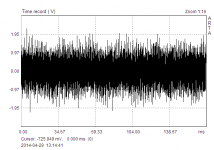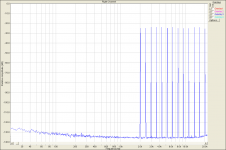I haven't seen Anyone here discount the science , but wait , who would have thunk it, a novel idea , ABX TESTING with level matching and a special switchbox....
talk about 50yr old ideas ...
You seem to discount science at every opportunity. It is a novel idea when you refuse to do any ABX at all . I suppose you really don't trust your ears.
I don't trust the test.
I think SY puts a bit more method into it than we do always room to improve. It is another tool that adds to understanding and you can weight it or ignore it if you want. More than one approach to good product. Your current methods seem to work for you John.
I don't trust the test.
Then all you have is a bunch of hand-waving.
se
It depends on the design, but 5 or 6 for coupling is different to hundreds used for decoupling...and on some designs size is critical.
Wouldn't a silicon cap be essentially the same as a glass cap? http://www.avx.com/docs/Catalogs/gl-cyintro.pdf The dielectric is the same material to start with I believe. IC processing allows much smaller and denser parts.
Hi Scott
It is "on /off" modulation of a tone, the on / off rate begins at a low F and ends higher.
The evaluation is "if" the process under test can go from on to off rapidly.
The analogy might be the rapidly changing black and white bands.
The STIpa test has a high degree of correlation to ineligibility of random words and is language independent, that suggests this type of measurement is dancing in the area where the "information" held in the time domain.
When you include a loudspeaker in a generation loss test, better mtf's normally go along with more generations before subjectively falling apart.
Best.
Tom
That's valid for a speaker in a space. It tests for reverberation and distortions that would obscure the details in speech. For electronics it only makes sense if the system has a reverb/eq in it. On most of these tests, including the full spectral contamination test I have yet to see even a medium grade sound card that can't pass it with without distortion on a loopback test. I don't have a single ended 3W triode amp to try with it but even an LM3886 can pass it at full power with no significant degradation.
I don't think it would yield much in decent electronics. We need to look elsewhere.
I also have test equipment, how about you?
The ability to think, discuss, and argue rationally.
se
I use the Belcher test all the time. Also notched noise and TIM square.
Problem is that it does not reveil anything new in linear electronics that a conventional measurement does not show.
For codec´s and speakers it is very usefull though.
Here you can see some shots i made from the bespoke AD797 intrumentation stage i mentioned. There is some life under -120dB but if that is audible i do not know.
The first picture is the noise notch, then the Belcher test and then the TIM square method.
The last picture shows an open loop JFet phono input. Here you can see some distortion and also a lower noisefloor then the AD797 ( paralleled ) stage can manage.
Hi Joachim,
I appreciate your input, and I have similar experience. With multitone, notched noise or FM modulation tones I have never found anything unexpected and, more important, the methods have had not enough resolution. A conventional CCIF 19+20kHz spectrum and THD spectrum at different frequencies and amplitudes have revealed more than the 'special' signals.
I think John Atkinson is still "learning " the Audio Precision test equipment he has had for the past 30 plus years.
He has had a new SYS-2722, for about 6 or more years.
There's only one way to know for sure, and that's by doing a real listening test.
I have two of these same make/model amps.... So an A-B is not out of the question. Even an ABXYZ. But it would have to be differently done --- cant just remove input signal back and forth with a switch..... the THD/bias/temp goes into its unintended worst doing that. Would have to sub a R for speaker during A or B when going to listen -- going back and forth with the output sides always connected to a load and inputs in parallel.... just selecting high level signal.
Anyway, I heard this amp for years and thus know a change when i hear it. If it was an amp i never heard before... like in a magazine review sitauation... OK. But I could do it... just need a good high current switch and to keep turn them both on all the time. Doing only input level switching -- signal/no siganl on amps leads to much higher distortion than if they both remain temp stable. results of that kind of testing.. low signal switching are all null and void and have to start over.
THx- RNMarsh
Last edited:
2 VladimirK and JC
What do You mean, what kind of signal is it ?
Just VladimirK and JC have been asked, right?
... like in a magazine review sitauation...
For magazine reviews, I would suggest to place the amplifier under test behind the curtain and never tell the reviewer what is tested. Then, he should write a review based on listening only, without having an idea what amplifier it was. One assistant might help to operate the amp and associated equipment.
At this time yes, I suppose You know it.Just VladimirK and JC have been asked, right?
- Status
- Not open for further replies.
- Home
- Member Areas
- The Lounge
- John Curl's Blowtorch preamplifier part II

